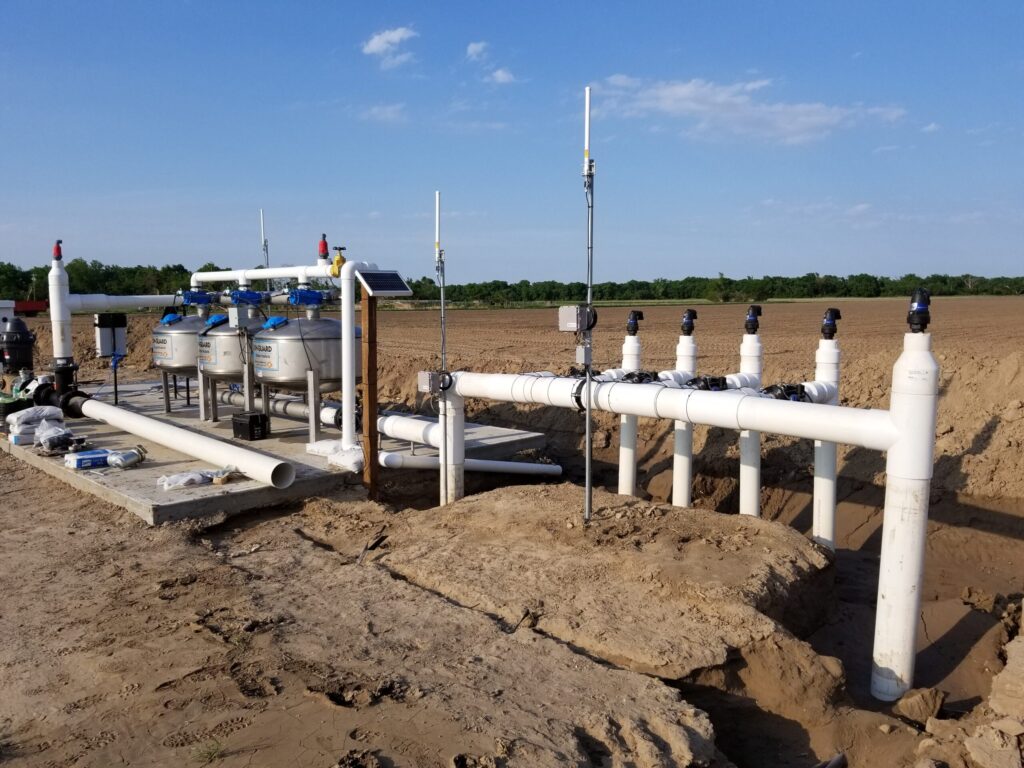Subsurface Drip Irrigation Installation Checklist for Large-Scale Farms
Subsurface Drip Irrigation Installation Checklist for Large-Scale Farms
Water is the lifeblood of any farm, but managing it efficiently across hundreds or thousands of acres can be a challenge. Traditional irrigation methods often waste water through evaporation, runoff, or uneven distribution. That’s where subsurface drip irrigation (SDI) comes in.
SDI delivers water directly to the root zone of crops through buried drip tape or tubing. This method minimizes water loss, reduces weed growth, and can significantly improve crop yields. For large-scale operations, SDI offers a level of precision and efficiency that’s hard to match with surface irrigation or overhead sprinklers.
But subsurface drip irrigation installation isn’t as simple as laying some pipe and calling it a day. It requires careful planning, proper equipment selection, and attention to detail during installation. Skip a step, and you could end up with uneven water distribution, clogged emitters, or costly repairs down the line.
Why Subsurface Drip Irrigation Works for Large-Scale Farms
Large farms face unique challenges when it comes to irrigation. Managing water across vast acreages while dealing with variable soil types, topography, and crop needs requires a system that’s both efficient and adaptable.
SDI addresses these challenges in several ways:
- Water efficiency: By delivering water directly to plant roots, SDI can reduce water usage by 30-50% compared to traditional methods. That’s a significant savings, especially in regions facing water scarcity or high water costs.
- Improved crop yields: Consistent moisture levels in the root zone create optimal growing conditions. Many farmers report yield increases of 10-20% after switching to SDI.
- Reduced labor costs: Once installed, SDI systems require minimal manual intervention. Automated controls can manage watering schedules across your entire operation, freeing up labor for other tasks.
- Weed control: Since water is delivered below the soil surface, the top layer stays drier. This creates an inhospitable environment for weed seeds, reducing the need for herbicides.
- Flexibility: SDI works with a wide range of crops, from row crops like corn and cotton to vegetables, orchards, and vineyards.
For large-scale operations, these benefits add up quickly. The initial investment in an SDI system typically pays for itself within 3-5 years through water savings, increased yields, and reduced labor costs.

Pre-Installation Planning: Setting Your System Up for Success
The success of your SDI system depends heavily on what happens before the first length of drip tape goes in the ground. Proper planning ensures you select the right equipment, design an efficient layout, and avoid costly mistakes.
Assess Your Land and Water Resources
Start by gathering detailed information about your farm. This includes:
- Soil type and texture: Conduct soil tests across different zones of your farm. Clay soils hold water longer but may require closer emitter spacing. Sandy soils drain quickly and may need more frequent watering.
- Topography: Map elevation changes across your fields. Significant slopes may require pressure-compensating emitters or additional mainline zones.
- Water source analysis: Test your water quality for pH, salinity, and suspended solids. This information helps determine what filtration and water treatment equipment you’ll need.
- Water availability: Calculate your total water supply and flow rate. Make sure it’s sufficient to irrigate your entire acreage during peak demand periods.
Design Your System Layout
Work with an irrigation specialist to create a detailed system design. This should include:
- Mainline and submain placement
- Drip tape spacing and depth
- Emitter flow rates and spacing
- Filtration and water treatment equipment
- Control valves and automation components
For large-scale farms, zone your fields based on crop type, soil conditions, and topography. This allows you to customize watering schedules for different areas and maximize efficiency.
Select Quality Equipment with Western Irrigation
The equipment you choose will determine how well your system performs and how long it lasts. Cutting corners on components might save money upfront, but it often leads to higher maintenance costs and system failures.
Western Irrigation specializes in providing high-quality SDI systems designed for large-scale agricultural operations. Their team can help you select:
- Drip tape or tubing: Choose the right wall thickness, emitter spacing, and flow rate for your crops and soil conditions.
- Filtration systems: Proper filtration prevents emitter clogging. Screen filters work for clean water sources, while media filters are better for water with organic matter or sand.
- Pumps and pressure regulation: Maintain consistent pressure throughout your system to ensure uniform water distribution.
- Automation and monitoring: Advanced controllers and soil moisture sensors allow you to fine-tune your irrigation schedule and respond quickly to changing conditions.
Western Irrigation’s experts can also provide guidance on system design, ensuring your layout maximizes efficiency and minimizes installation challenges.
Step-by-Step Installation Checklist
Once your planning is complete and equipment is on-site, it’s time to install your SDI system. Follow this checklist to ensure a smooth installation process.
Prepare the Field
Before any trenching begins, the field should be properly prepared:
- Remove crop residue and level the soil surface
- Mark the locations of mainlines, submains, and drip tape runs
- Identify and mark any underground utilities or obstacles
- Ensure the field is dry enough for equipment to operate without causing soil compaction
Install Mainlines and Submains
Your mainline distributes water from the source to different zones, while submains carry water to individual drip tape runs:
- Dig trenches for mainlines and submains according to your design specifications (typically 18-24 inches deep)
- Lay PVC or polyethylene pipe in trenches
- Install control valves, flush valves, and pressure regulators at appropriate locations
- Connect submains to mainlines using proper fittings
- Pressure test the mainline system before backfilling
Trench and Lay Drip Tape
This is the most critical phase of installation:
- Use specialized trenching equipment designed for SDI installation
- Set trench depth according to your crop type (typically 6-12 inches for most row crops)
- Lay drip tape at consistent depth and spacing throughout each zone
- Ensure drip tape is straight and free from twists or kinks
- Connect drip tape to submains using manifolds or direct connections
- Install end caps or flush valves at the end of each drip tape run

Connect to Water Source and Filtration
With drip tape in place, complete the connection to your water source:
- Install pumps, backflow preventers, and pressure regulators at the water source
- Connect filtration system according to manufacturer specifications
- Install fertilizer injection equipment if you plan to fertigate
- Wire electrical components and automation controllers
- Verify all connections are watertight and secure
Backfill and Surface Restoration
Protect your investment by properly closing trenches:
- Carefully backfill trenches, avoiding damage to drip tape or pipes
- Compact soil to prevent settling
- Restore the field surface to original grade
- Mark the location of valves, flush points, and other critical components
Post-Installation Testing and Maintenance
Installation the SDI system isn’t complete until you’ve thoroughly tested your system and established a maintenance routine.
Initial System Testing
Before putting your SDI system into regular operation:
- Flush the system: Open flush valves and run water through mainlines, submains, and drip tape to remove any debris from installation
- Check water pressure: Verify pressure at multiple points throughout the system. Readings should be consistent within each zone
- Inspect for leaks: Walk all mainlines, submains, and drip tape runs looking for wet spots or water pooling
- Test automation: If you’ve installed automated controls, verify that all valves open and close properly on schedule
Monitor Soil Moisture
Once the system is operational, pay close attention to soil moisture levels:
- Install soil moisture sensors at various depths in the root zone
- Check moisture levels regularly during the first few weeks of operation
- Adjust watering schedules based on actual soil conditions rather than assumptions
- Watch for signs of over- or under-watering in your crops
Establish a Maintenance Schedule
Regular maintenance keeps your SDI system running efficiently for years:
Weekly during growing season:
- Check pressure gauges for abnormal readings
- Inspect filtration system and clean or replace filters as needed
- Walk fields looking for signs of equipment malfunction or crop stress
Monthly:
- Flush mainlines and submains
- Test and calibrate fertilizer injection equipment
- Review irrigation schedules and adjust based on weather and crop stage
End of season:
- Thoroughly flush the entire system
- Apply acid treatment to prevent mineral buildup in emitters
- Inspect and repair any damaged components
- Winterize system in cold climates by draining all lines
Troubleshoot Common Issues
Even well-designed systems can experience problems. Watch for these common issues:
- Uneven water distribution: Often caused by pressure variations, clogged emitters, or damaged drip tape
- Emitter clogging: Usually the result of inadequate filtration or lack of regular maintenance
- Rodent damage: Gophers and other rodents can chew through drip tape. Install wire mesh in problem areas
- System leaks: Address leaks immediately to prevent water waste and potential crop damage
Western Irrigation offers ongoing technical support to help you troubleshoot issues and optimize system performance. Their team can provide remote assistance or dispatch technicians for on-site service when needed.

Why Choose Western Irrigation for Your SDI System
Installing a subsurface drip irrigation system on a large-scale farm is a significant investment. Partnering with an experienced supplier like Western Irrigation ensures you get a system that’s properly designed, uses quality components, and delivers reliable performance for years to come.
Western Irrigation brings several advantages to your SDI project:
- Expertise in large-scale agriculture: Their team understands the unique challenges of irrigating thousands of acres and can design systems that scale efficiently.
- Quality products: Western Irrigation sources components from leading manufacturers known for durability and performance in demanding agricultural environments.
- Comprehensive support: From initial planning through installation and ongoing maintenance, Western Irrigation provides guidance every step of the way.
- Local knowledge: With deep roots in agricultural communities, they understand regional soil conditions, water challenges, and crop requirements.
- Long-term partnership: Your relationship with Western Irrigation doesn’t end when installation is complete. They’re available for technical support, system expansions, and equipment upgrades as your operation evolves.
Set Your Farm Up for Long-Term Success
Subsurface drip irrigation (SDI) is a game-changer for large-scale farms, offering decades of reliable service when properly planned and maintained. It conserves water, boosts yields, and reduces labor costs, making it a smart investment for long-term success.
To maximize the benefits, focus on thorough planning, quality equipment, expert installation, and regular maintenance. Start by gathering data on your land and water resources, then work with specialists to design a system tailored to your needs. Prioritize durable components and establish a maintenance routine to keep your system running efficiently.
Treat SDI as a precision tool that requires care and attention, and it will reward you with higher productivity for many seasons. Ready to optimize your farm’s water management? Contact Western Irrigation for a custom SDI system designed to fit your operation.
